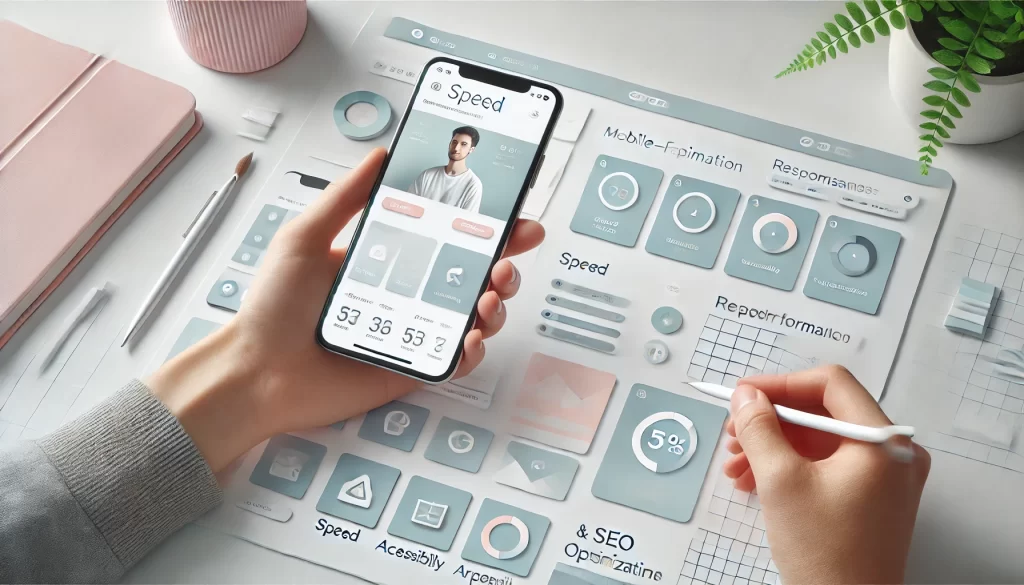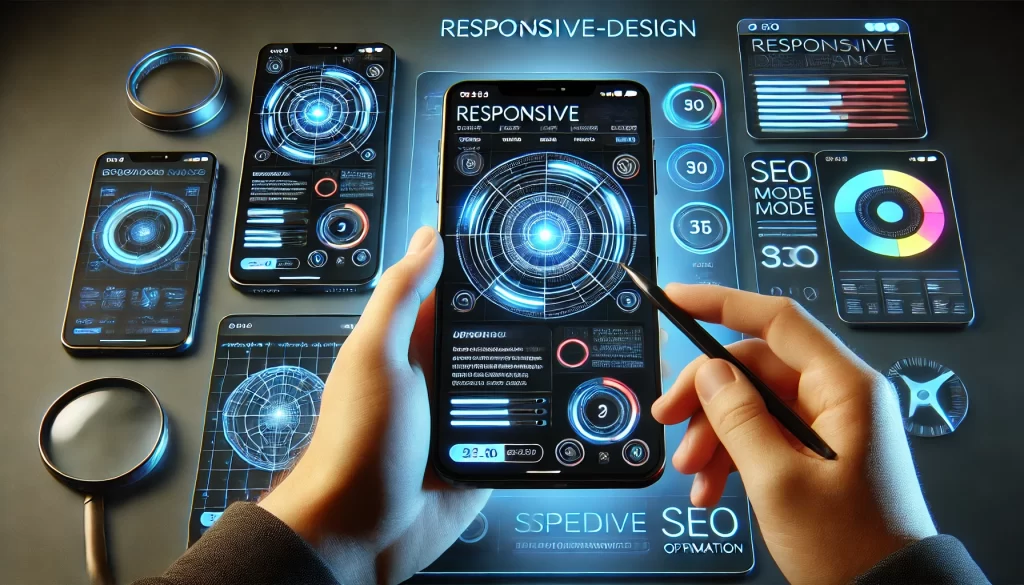As smartphones and tablets dominate internet usage, businesses can no longer afford to ignore the importance of a mobile-friendly site. With mobile traffic outpacing desktop usage, ensuring that your website provides an optimal experience across all devices is essential for both user satisfaction and SEO performance. In this article, we will explore the key characteristics of a mobile-friendly site, the differences between mobile and desktop design, and the steps you can take to ensure your website is fully optimized for mobile users.

Why a Mobile-Friendly Site Is No Longer Optional, But a Necessity
With the increasing prevalence of mobile devices, having a mobile-friendly site is no longer a luxury, it is a necessity. More than half of all global internet traffic comes from mobile devices, and this number continues to grow. Whether running a small business or managing a large e-commerce platform, neglecting mobile optimization could result in lost opportunities, higher bounce rates, and lower conversion rates.
Google’s mobile-first indexing, which prioritizes mobile-friendly websites in search results, makes mobile optimization even more crucial for SEO. If your website isn’t mobile-friendly, you risk not only alienating potential customers but also seeing a negative impact on your search engine rankings.
The Impact of Mobile-Friendly Sites on Business Performance
The shift towards mobile-first browsing affects every aspect of web marketing. Websites that aren’t optimized for mobile devices often load slowly, have poor navigation, or display distorted content, all of which negatively impact the user experience. As a result, visitors are likely to leave your site in frustration, leading to a higher bounce rate and lost conversions.
A mobile-friendly site ensures that your content is accessible, easy to navigate, and engaging, regardless of the device being used. It increases user satisfaction, boosts your SEO performance, and ultimately contributes to higher sales and improved brand reputation.

Differences Between a Mobile-Friendly and Desktop Site
Although both mobile and desktop versions of a website serve the same purpose—providing information, products, or services to visitors—the way they are designed and displayed can be quite different.
Layout and Design
A mobile-friendly site adapts its layout to suit smaller screen sizes, ensuring that elements are easy to read and interact with. A desktop website, on the other hand, is designed to take advantage of larger screens, often displaying more information in a single view.
Navigation
Navigating a website on a mobile device requires touch-friendly navigation, with larger buttons, simple menus, and swipe-friendly features. Desktop sites, however, are typically designed for keyboard and mouse interaction, allowing for more complex navigation structures.
Load Times
Mobile devices, especially when using cellular data, often experience slower internet speeds compared to desktops. As a result, a mobile-friendly site should be optimized for speed, with compressed images and fewer heavy elements to ensure quick loading times.
Performance and Features
While desktop sites can have more complex features and graphics, a mobile-friendly site must simplify certain elements for smoother performance on mobile devices. For example, animations, background images, and large files need to be carefully optimized for mobile to avoid lag and slow loading.
Key Characteristics of a Mobile-Friendly Site
To meet the demands of mobile users and provide the best experience, a mobile-friendly site should include several essential characteristics. Let’s take a closer look at the key elements that define a mobile-friendly site:
Screen Size and Resolution Adjustments
A mobile-friendly site should adjust its layout according to the screen size and resolution of the device. For instance, a site that looks perfect on a 24-inch desktop screen may appear cluttered and difficult to read on a smartphone. Responsive web design ensures that all content, including text, images, and buttons, scales appropriately to fit smaller screens without the need for zooming or horizontal scrolling.
Touchscreen Navigation
Navigation on mobile devices should be intuitive and easy to interact with via touch. Buttons and links need to be large enough for users to tap without difficulty. Avoid small text links, drop-down menus, or navigation items that are too close together. For example, a mobile-friendly site often employs a hamburger menu, which hides navigation options behind a simple icon, freeing up valuable screen space.
Fast Loading Speeds
Mobile users expect websites to load quickly. Long loading times can frustrate users and increase bounce rates. A mobile-friendly site needs to be optimized for speed by reducing image sizes, eliminating unnecessary JavaScript, and minimizing HTTP requests. Tools like Google PageSpeed Insights can help you identify and fix performance issues.
Content Readability Without Zooming
Content on a mobile-friendly site should be legible without zooming. This means that text should be large enough to read comfortably, even on smaller screens. It’s essential to use readable fonts, good contrast, and appropriate line spacing to enhance readability. Avoid cluttered text, as it can be difficult to digest on mobile screens.
Optimized Media and Images
Mobile users typically have limited data bandwidth, so optimizing images and media files is crucial. A mobile-friendly site ensures that images are compressed and displayed in appropriate sizes, ensuring fast loading times without compromising quality.
Easy-to-Use Forms
Forms, such as contact forms or sign-up forms, need to be user-friendly on mobile devices. Fields should be large enough for easy input, and auto-fill features should be enabled to save users time. Avoid complex forms that require a lot of typing, as mobile users may find them cumbersome.
Mobile-First Design vs. Desktop-First Design
When designing a website, the choice between mobile-first design and desktop-first design is a key decision. Mobile-first design involves creating the mobile version of the site first and then adapting it to larger screens. Desktop-first design, on the other hand, begins with a design that works well on desktops and later adapts it to mobile devices.
Principles of Mobile-First Design
- Simplified Layout: Mobile-first design encourages simplicity, focusing on the core features and content.
- Optimized Performance: The smaller size of mobile screens means that mobile-first design emphasizes fast load times and lightweight elements.
- Touch-Friendly Interactions: Buttons and links are designed to be easy to tap on small screens.
Pros and Cons of Mobile-First Design
Pros:
- Improved user experience for mobile visitors.
- Faster page load times, as mobile-first design tends to be leaner.
- Better alignment with Google’s mobile-first indexing, which prioritizes mobile-friendly sites in search results.
Cons:
- Designing for small screens first can limit the design complexity.
- It may be challenging to add extra features later, as the site was initially designed for mobile.
Common Challenges in Creating a Mobile-Friendly Site
While designing a mobile-friendly site is crucial, it comes with its challenges. Let’s take a look at some common hurdles developers face when optimizing websites for mobile:
Difficulty with Responsive Design on Complex Layouts
Websites with complex layouts or extensive content may struggle with responsive design. Achieving an optimal display across various screen sizes can be tricky without sacrificing usability or aesthetic quality.
Performance Issues (Large Images Slowing Down Load Times)
Large images and media files can cause significant delays in mobile page load times. Compressing and optimizing media without losing quality is essential to maintaining a fast-loading mobile-friendly site.
Maintaining Functionality Across Devices
Ensuring that a website works seamlessly on multiple devices, including smartphones, tablets, and desktops, can be a difficult balancing act. Testing across various platforms and screen sizes is critical to ensure that your site is mobile-optimized.
Tools to Optimize Your Site for Mobile
Optimizing your website for mobile doesn’t have to be a daunting task. There are many tools available that can help you identify areas for improvement and optimize your site accordingly.
Google PageSpeed Insights
Google PageSpeed Insights is a free tool that analyzes your website’s performance and provides suggestions for improving load times, mobile optimization, and overall performance.
WebPageTest
WebPageTest offers detailed performance analysis, including mobile-specific tests. It helps you identify potential issues that could slow down your site and provides recommendations for improvements.
Mobile Emulators
Mobile emulators allow you to test how your website looks and functions on different devices. By using emulators, you can simulate a variety of screen sizes and resolutions to ensure that your site is truly mobile-friendly.
Key Takeaways
A mobile-friendly site is no longer a nice-to-have feature, it’s essential for business success in today’s mobile-first world. Mobile users expect fast-loading, easy-to-navigate websites, and failing to meet these expectations can result in lost visitors and lower conversion rates. By following mobile-first design principles, optimizing performance, and testing across multiple devices, you can create a seamless and engaging user experience that enhances your brand’s digital presence.
- A mobile-friendly site provides a positive user experience and improves SEO performance.
- The mobile-first design focuses on simplicity, performance, and usability for mobile users.
- Tools like Google PageSpeed Insights and WebPageTest help optimize your website for mobile devices.
- Testing and optimization are essential to ensure your website functions properly across various devices.
FAQs
What is a mobile-friendly site?
A mobile-friendly site is optimized for easy viewing and interaction on mobile devices, such as smartphones and tablets.
Why is a mobile-friendly site important for SEO?
Google’s mobile-first indexing prioritizes mobile-friendly sites in search results, improving visibility and rankings.
How can I test if my website is mobile-friendly?
You can use tools like Google’s Mobile-Friendly Test or WebPageTest to check if your website is optimized for mobile devices.
What are the key elements of a mobile-friendly site?
Key elements include responsive design, fast loading times, touchscreen navigation, and readable content without zooming.
What is mobile-first design?
Mobile-first design is a web development approach that starts by designing the mobile version of a site before adapting it for larger screens.
How can I improve my mobile site’s loading speed?
To improve loading speed, compress images, reduce the use of large media files, and minify JavaScript and CSS files.
